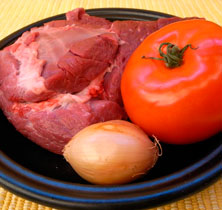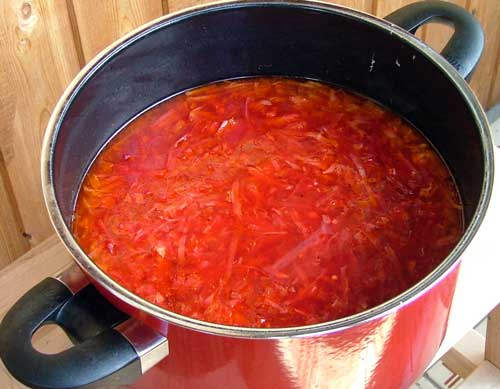
|
|
|||||||||||
First of all decide on the cooking sing size. Normally 5 litres would be enough. 3 is not worth the effort, 8 will not fit the fridge. I wouldn’t advice storing it outside especially at the winter – once frozen and defrosted the borsch will never be the same. Since we’re to follow the rules, lets start with the meat. A good quality meat. With a bone, of course. Take 1kg meat, put it in the sink and cover with a cold water. Put it on the fire. There are some common rules: Once the water had boiled remove the foam and put an onion and a fresh tomato into the sink. Both the onion and the tomato need to have a cut. Other things (though not necessary) to put in the sink are a carrot and the celery. The tomato is a must though. If you don’t have one steal it, grow it on your balcony. Whatever. It takes all the not needed parts from the meat – the cholesterol, and other disgusting stuff. For those who have kids in the sport the bouillon made that way is a good thing to eat. Let it boil on a small fire for 2-3 hours with a slightly opened cover. My grandmother used to cook the bouillon from the evening till the morning in a huge sink. At the morning it was clear, transparent and incredibly tasty..
If there is too much bouillon freeze a part of it in a plastic or glass made dishes. That way you will have a base for any soup or borsch a handy, besides, it’ll save you 2 hours of cooking next time you’ll decide to make a soup. Now, to the borsch. When the meat is ready (it becomes soft. Pick it with a fork to see. By that time the bouillon should become 2/3 of what it was i.e. 2.5-3 litres) put 2-3 whole potatoes into the sink. The whole potato (don’t forget to clean it first!) takes about 30 minutes to be cooked. It’s enough time to do the other things. So, what is the rest? Put an oil into a deep frying pan. If you have some bacon – cut it into a tiny pieces and put into the frying pan as well. Just 1-2 spoons of bacon will change the flavour and the smell of the borsch. Throw a couple of big onions cut into as tiny pieces as possible into the frying pan (to cut the onion first cut it in 2, then each half cut horizontally into the smallest stripes. I usually leave the “tail” of the onion as something to hold the onion while cutting it). While the onion is frying (till it becomes golden) on a medium fire (don’t burn it! Make sure you stir it constantly) clean a carrot (just one) and cut it vertically (in long thin pieces). Don’t use the grater, cut it with a knife! Throw the carrot into the pan where your onion is. You may turn the fire to the minimum and leave it while you’re dealing with the red beet (one, average size) - if it is very young and fresh you can use it together with the leafs.
.
Peel the beet and cut it the way you cut the carrot. Splash it with some vinegar or lemon juice so it won’t loose it’s colour and throw into the pan where the carrot and the onions are cooking. Make the fire a bit bigger – the beet has to fry a bit as well. (I don't have a picture of a red beet at a moment - it is not a usial thing for the alimentary stores in Europe but it's quite easy to find it at a vegetable market). Put some pepper on the onions in the frying pan (not too much though – about ¼ of a spoon) – either the coarsely ground black pepper or a red – just cut the dry pepper pod or a small cut chili, but remember, here is where you decide how hot your borsch will be. Put the same amount of salt. The same or a bit less of sugar. Sugar will emphasize the flavour of all the other products. Some would add some more spices, whatever they like. Now take a can of chopped or sliced tomatoes. You’ll need a glass or glass and half. A big glass though. 0,4 or 0,5 l. Put it into the same frying pan (remember, it was supposed to be deep?). Instead of the canned tomatoes you can use the fresh ones - cut them into the small pieces, but that’s only good for the summer, when there are fresh well smelling tomatoes. The rest of the year it’s a disappointment and not a vegetable. Don’t even bother. Let’s add the tomatoes to the other vegetables in the frying pan and stir it all a bit. Once it’ll start boiling put the fire to the minimum, close the cover and let it cook for about 15 minutes. Here is the picture just to show how "thick" it usially looks in the pan (don't pay attention on details - the tomatoes are cut in a different way here and there is not beet inside - the color should be more dark-red)
Use those 15 minutes to wash up. My friend’s Armenian grandmother used to say a good cook is not the one who can cook, but the one who doesn’t have dirty dishes after she’s done cooking. Done? Ok, lets go on. Take a piece of garlic, clean it and slice into the small pieces. Into the frying pan it goes. Stir again and take it off the fire immediately. Enough! By the way, when cooked like that the garlic gives all it’s hotness to the other ingredients. In other words, no matter how much garlic you put you won’t smell of it after, while the soup will be hot, but not burning hot (well, that is, if you didn’t exaggerate with the chili before) Now let’s assembly the borsch. Pick the potato with the knife. Is it soft? Mash it in the sink, but don’t work too hard. Take the meet out to cut it and put it straight on the plates. Cut about half of white cabbage small head (enough so you can hold it in your hands) into the thin (thin! Not small!) pieces and put them into the sink. Don’t worry about more than half of your sink being liquids. You still have all that frying pan to put in.
Don’t go away! Keep stirring the cabbage till it boils. No more than a minute later put into the sink the insides of the frying pan. Is it too solid? Dig out some vegetables and eat them, but don’t tell anyone. Otherwise they might want some too! It is allright to slice a sour apple into the borsch (first peel the apple’s skin). I always do. That is if I don’t forget to buy that apple first. Now check the salt level. Now is the time to add the salt if there isnt’ enough. Boiled again? Take it off the fire immediately, cover and let it brew a bit. The borsch is always better on the 2nd day. Serve it with a spoon of sour cream and melted dill or parsley. Bon Appétit, Stephan!
|









